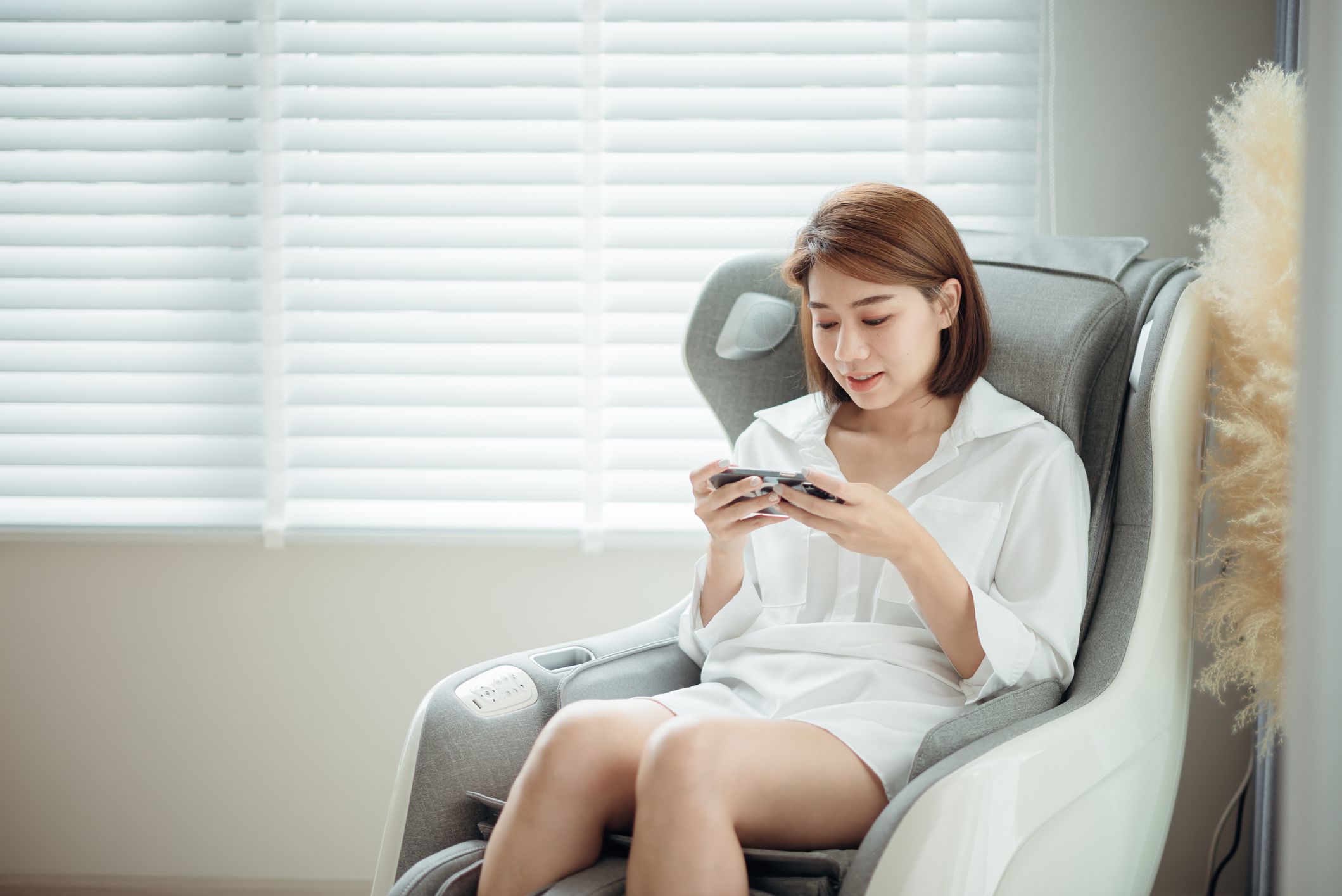
We independently research, test, review, and recommend the best products—learn more about our process. If you buy something through our links, we may earn a commission.
Though it's not an exact substitute for a professional massage, an at-home massage chair (often styled just like your living room recliner) can offer some of the same benefits: targeted physical relief to areas like the back, shoulders, hips, and feet, using a combination of Shiatsu techniques, heat therapy, and compression massage.
According to Preston Brown, DPT, owner of Prestige Therapy Wellness in Wisconsin, massage chairs can reduce muscle tension, improve relaxation within the body, and help decrease pain or muscle tightness caused by chronic conditions like arthritis—all from the comfort of your home. Brown explains that when shopping for a massage chair, you need to “consider the size of the massage chair to ensure proper fit, safe access to the chair, and comfort,” says Dr. Brown, “and some massage chairs have features for enhanced massage experiences like heat, programmable massages, vibration, and reclining features.”
To help you narrow down your choices, we researched dozens of massage chairs and evaluated them for their number of massage functions, targeted massage areas, heating and reclining capabilities, comfort, and price.
Here are the best massage chairs on the market today.
Final Verdict
Anyone looking to buy an all-purpose massage chair with many of the most popular features on the market (read: voice control, zero gravity, and multiple massage modes) would find something to like about the Real Relax Zero Gravity Massage Chair. It targets your back, neck, and waist with dual-core S-track massage rollers, simulating the feeling of a professional, hands-on massage. Plus, at an affordable price point, it’s an investment that won’t break the bank.
If your lower back is your biggest concern, we like how the RELAXONCHAIR MK-II Plus Full Body Massage Chair stretches and decompresses your spine for maximum massage relief. On the other hand, if your neck is your priority area, you may want to opt for the Snailax Shiatsu Neck & Back Massager Chair Pad over a traditional reclining chair; the pad can more easily target the contours of your neck and shoulder, directing massaging rollers and heat right to the source of your pain.
How We Selected the Best Massage Chairs
To find the best massage chairs, we asked three orthopedic specialists, including two physical therapists and one chiropractor, to tell us what features are the most important ones to consider. They strongly suggested paying close attention to the areas of the body targeted, the adjustability and range of massaging features, and your overall comfort with the chair itself (i.e. how well it fits your body).
We scoured the internet for popular massage chairs with features like heat therapy, Shiatsu massage, “smart” capabilities, and overall quality and comfort. We also kept the price range between $1,000 and $2,000; while there are plenty of more expensive options out there, we believe the vast majority of consumers are looking for a more affordable way to find the relief they need.
What to Look for in Massage Chairs
Massage Functions
While massage chairs seem to have a lot of bells and whistles, it’s actually fairly important to choose one with many customizable settings, modes, and features so you can make it as comfortable as possible for your unique needs.
“Not all people are built the same, [and] this goes for pain as well,” says Dr. Blessen Abraham, a chiropractor at Brunswick Health & Physical Therapy Center in New Jersey. “Your pain level can change daily, so any massage that you receive needs to adapt to your pain level [each day].”
Dr. Abraham suggests looking for a chair with various levels of pressure, and both reclining and heating features. Regardless of your reason for using a massage chair, most people will require these functions, at minimum.
Additionally, you should make sure any chair you choose can check off the following boxes:
- It’s comfortable for you to sit in.
- Your body fits correctly in the designated areas of the chair (i.e. if you’re very short or tall, make sure your body is aligned properly with the rollers and that you aren’t sinking in or sticking out of the chair too much).
- It gives you your preferred method of massage, such as Shiatsu, kneading, rolling, tapping, and so on.
- It’s easy for you to control the movement of the chair; whether you prefer voice or manual control, you should be able to quickly direct the chair to do what you want it to.
- It's safe for elderly users to get in and out of the chair, even if they're using a walker or wheelchair.
Targeted Massage Areas
Different massage chairs focus on different areas of the body; some provide targeted relief to two or three areas, while others market themselves as “full body” massage chairs, offering a little bit of everything from your head to your toes.
According to Dr. Abraham, any chair you buy should at least be able to address pain or tension in your shoulders and lower back: “The back is a focus for most chairs that are available in the market today, [and] if it can massage your calves or your neck area, that would be [even better].”
Before purchasing, make sure your chair offers some kind of relief to the area you need it most, whether it’s through rolling massage, heat therapy, or air compression.
“The body part you want to focus the massage on can influence which massage chair you choose,” says Melissa Prestipino, DPT, owner of Maize & Blue Rehab in New Jersey. “If you have pain in your hands, pick a chair which targets the hands; if you prefer heat therapy, find a massage chair that can heat up or apply infrared heat.”
Additional Features
As massage chairs have continued to advance technologically, many of them have added even more sophisticated features. But are they worthwhile?
- Zero gravity. This can give a weightless feeling to the user, which can be a relief for people with all-over pain. But it’s not the only thing you should look for: “There are some chairs that offer zero gravity, meaning you’ll feel [like] there’s no weight on your spine, but that doesn’t mean it’s going to give you all the other features you want.”
- Bluetooth connectivity. This is a personal preference: if you want to be able to listen to your carefully curated playlist of zen meditation songs with the touch of a button during your massage, a wireless connection to your smart device or computer will make this a breeze. If you don’t really care about that, don’t pay extra for a chair that comes with it. “Some features for the massage chairs can add to the costs but don't make the chair better,” says Dr. Prestipino. “Adding Bluetooth speakers to a massage chair's headrest does not impact the effectiveness of the massage features.”
- Appearance and construction. Most chairs in the $1,000 to $2,000 price range are made with synthetic leather, not the real deal—so keep that in mind if it’s important to you. Also think about the size of these chairs, which tends to be pretty large, and if it will actually fit in your living space. “Most of these chairs are not pretty, so how it feels in your home can make a big difference on your purchase,” advises Dr. Abraham.
- Warranty. A massage chair can be a large purchase, so it’s smart to ask if there is any warranty coverage should the chair malfunction or stop working soon after you get it home. Some higher priced chairs, says Dr. Prestipino, may come with extended customer service or warranty policies, but don’t assume that’s the case.
Price
Per Dr. Abraham, massage chairs have a wide price range and can cost as much as $7,000 before delivery and assembly; you should consider whether the chair you’re planning to buy is in your budget, or if you can sacrifice some features you don’t really need for a less expensive chair.
And don’t assume that “settling” for a less expensive chair means you’re getting a chair of lesser quality, either: “A higher price tag for a chair does not necessarily mean it is better quality—a brand name or patented feature could drive the cost of the chair higher,” says Dr. Prestipino.
She also notes that, just like so many other devices we use every day, newly-released models may be more in demand—and thus more expensive—than a previous model, even if that previous model works essentially the same as the new one. Take your time to shop around and compare models, making note of the features you truly need and the ones you don’t, before picking a chair that has what you want and fits within your budget.
Frequently Asked Questions
As far as short-term duration goes, a massage chair can be used for brief sessions once a day or several times per week in most cases; there are exceptions, though, depending on your condition or the reason you’re using the chair.
“While there is no set recommendation on how long to use a massage chair, it is best to avoid sitting for longer than 15 to 20 minutes at a time,” says Dr. Prestipino. “If you would like to sit in the massage chair for a longer duration, it is best to complete shorter bouts of sitting and repeat it two to three times throughout the full day.”
Why? Because extended sitting, Dr. Prestipino says, can cause strain on your lower back or discs, not to mention increase your chances of blood clots in the legs (which you’re more prone to if you’ve recently had surgery). Sitting too long in the chair can also cause the muscles of your back and neck to tighten, as well as the joints in places like your knees to become stiff—a side effect that Dr. Prestipino says can worsen symptoms in the same areas you’re trying to find relief in.
As far as the long-term use of a massage chair (as in, how many months or weeks you can use it), she says it depends on the reason for your use. If you have muscle soreness or tightness, a chair could be used several times per week for several months at time; on the other hand, long-term use if you have herniated discs, neuropathy, vascular issues, or osteoporosis or bone density issues, could worsen symptoms or cause damage.
“If pain in any area of your body is worsening, or existing symptoms are getting exacerbated by use of the massage chair, [you should] see a healthcare provider and discontinue use,” Dr. Prestipino warns.
One other thing to note, per Dr. Brown: pregnant women should always consult their doctor before using a massage chair; while they’re not likely to cause any real harm, there are some minor concerns associated with their use that you should get an expert opinion on.
Yes. According to Dr. Prestipino, massage chairs can help with injury recovery by reducing stress and promoting relaxation, which can speed up the recovery process. She adds that they can also help with injuries by:
- increasing circulation and blood flow;
- decreasing post-exercise soreness;
- assisting in tissue repair;
- and decreasing inflammation.
While traditional physical therapy is still the gold standard for injury recovery, more research is being done about the effects of massage chairs on pain. One 2020 study in Medicine (Baltimore), for example, suggests that massage chairs can play a role in improving pain and quality of life.
According to Dr. Abraham, there is no direct correlation between massage chairs and lower blood pressure, but that doesn’t mean they can’t help shift things in the right direction.
“In theory, if you’re in pain, that would bring your stress level higher [and] your blood pressure up,” he says. “Once you get the massage, you should be more comfortable, [and that can] bring down your blood pressure.”
Why Trust Verywell Health
Sarah Bradley has been writing health content since 2017—everything from product roundups and illness FAQs to nutrition explainers and the dish on diet trends. She knows how important it is to receive trustworthy and expert-approved advice about over-the-counter products that manage everyday health conditions, from GI issues and allergies to chronic headaches and joint pain.






































































































